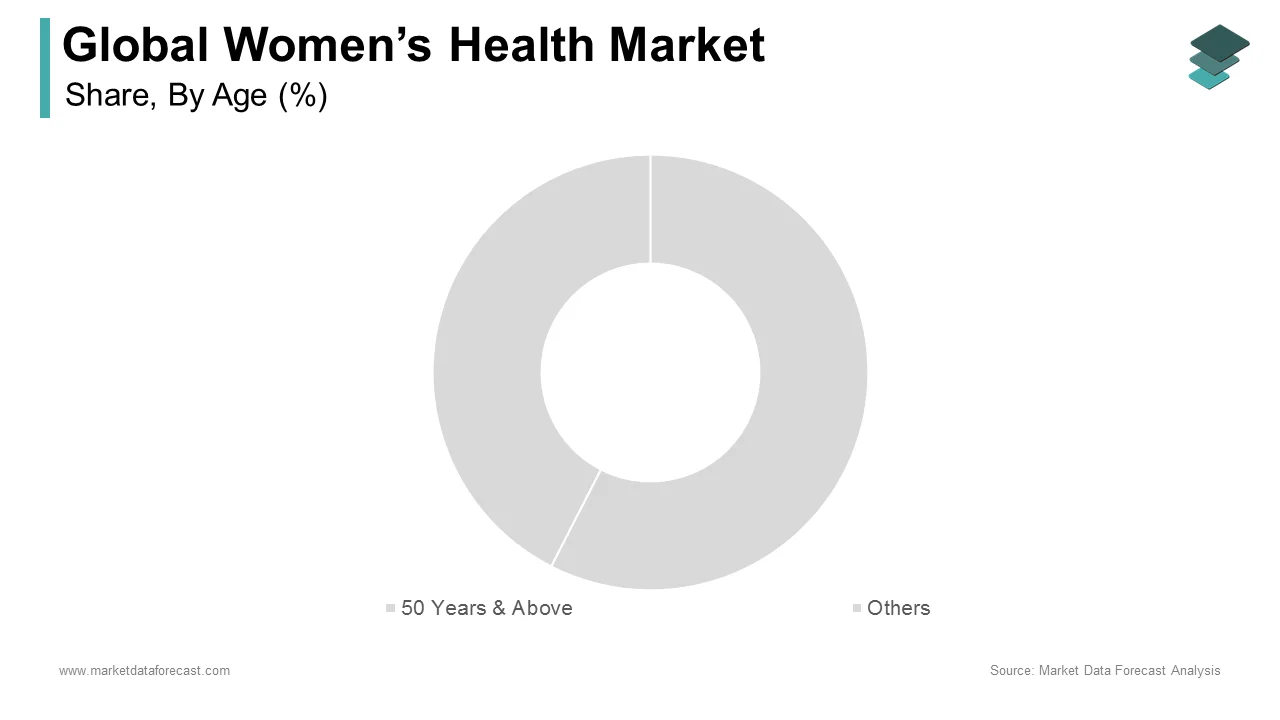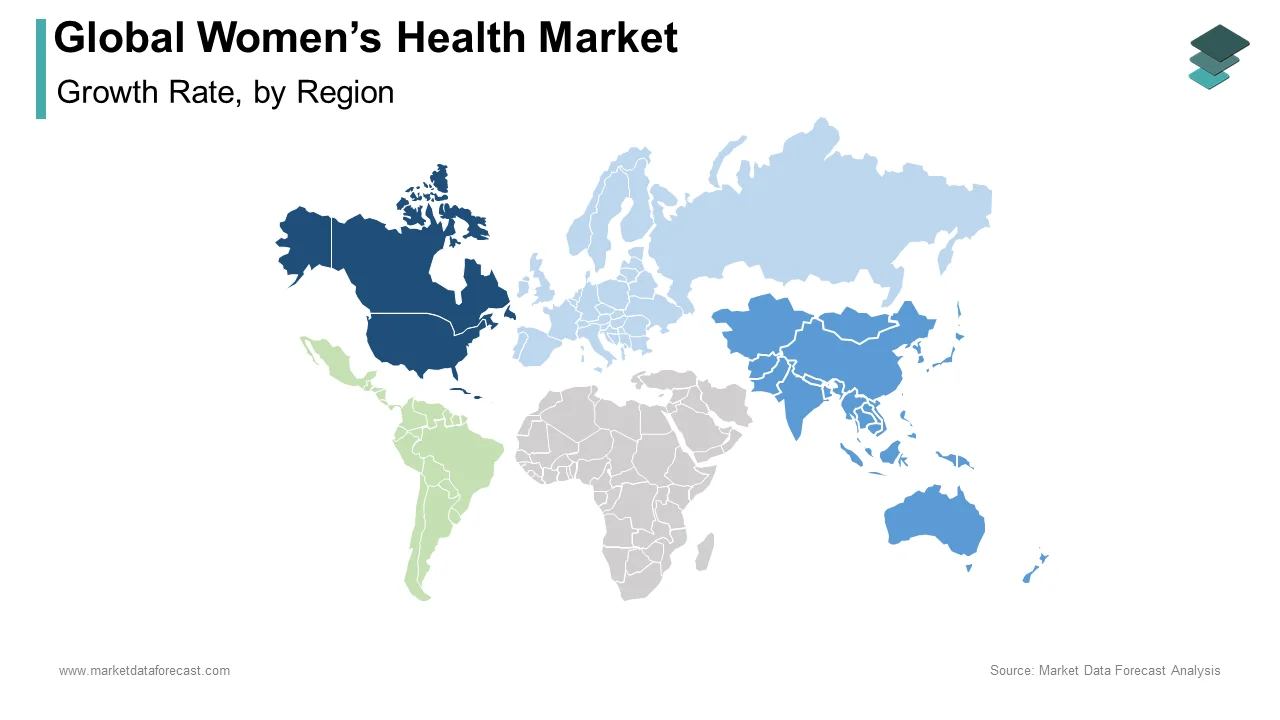Global Women’s Health Market Size, Share, Trends & Growth Forecast Report By Age, Application and Region (North America, Europe, Asia-Pacific, Latin America, Middle East and Africa), Industry Analysis From 2025 To 2033.
Global Women's Health Market Size
The size of the global women's health market was worth USD 47.4 billion in 2024. The global market is anticipated to grow at a CAGR of 5.54% from 2025 to 2033 and be worth USD 77 billion by 2033 from USD 50 billion in 2025.

Women and men have different physiological functions, varying degrees of diseases, and even different treatment methods. Therefore, healthcare, designed around the women population, is called women's health. The physical and emotional well-being targets the industries established in the women's health market. Several factors affect women's health, like gynecological care, menopausal care, hormonal imbalance, breast cancer, ovarian cancer, cancer in any other female body parts, STDs, osteoporosis, pregnancy, childbirth, etc. Therefore, it is essential to take regular diagnostics such as mammography, gynecological tests, pelvic tests, breast exams, etc. Therefore, sexual, gynecological, fertility, and infertility care for women's health is the center of this market's focus. The increasing cases of negligence or stereotypical unawareness about women's hygiene and health are propelling the need for this market in recent times.
MARKET DRIVERS
The global women's health market is primarily driven by the lack of care/negligence towards women's safety and hygiene worldwide due to the sociocultural gender discrimination deeply rooted in society.
Women's health is often overlooked and needs attention and awareness. Less educational rates among women, when compared to men, along with oppressed sexual choices, are making women vulnerable to more chances for STDs and unequal rights in the healthcare industry. According to the 2017 Stas from WHO, approximately 810 women lost their lives due to complications with pregnancy and childbirth every day. WHO stats also state that adolescents aged 15–19 years in low- and middle-income countries (LMICs) had an estimated 21 million pregnancies yearly, of which approximately 50% were unintended. Additionally, sexual, physical, and emotional violence against women is also a factor, as WHO states that around 3 in 10 women (30%) of the female population goes through some form of violence.
The imbalance between healthcare needs and healthcare services for women will augment women's health market growth.
The rising rates of geriatric populations in women augment the growth of diseases like osteoporosis, menstrual disorders, endometriosis, etc., and the rising cases of pregnancy complications and unwanted pregnancies along with postmenopausal complications like hot flashes, fatigue, obesity, etc., are all pushing the requirement for the market. However, the need for women's healthcare is currently unmet, and this gap in the healthcare system is promoting market expansion. In addition, the unmet need for contraceptives results in unwanted pregnancies and sexual health decline, supporting the need for the market.
Growing cases of women-related diseases help the women's health market grow.
The rates of PCOS, fertility issues, and gynecological problems are further promoting the growth of the women's health market. According to statistics, around 5-10% of women between the ages of 15-44 go through PCOS. There are also rising cases of endometriosis and uterine fibroids in women driving the need for the market. Furthermore, the rising use of contraceptive pills, sanitary pads, hormone balancers, birth control, etc., leads to more market growth. In addition, the latest awareness programs for women's health and the efforts of the newest generation to eradicate the taboos about female roles in society are helping the market's growth.
MARKET RESTRAINTS
On the other hand, free access to contraception leads to rising rates of unguided abortions and a lack of facilities for women, especially in low and middle-income countries, and the lack of education and awareness among women for their hygiene and health is expected to drag down the rise of the women's health market.
REPORT COVERAGE
|
REPORT METRIC |
DETAILS |
|
Market Size Available |
2024 to 2033 |
|
Base Year |
2024 |
|
Forecast Period |
2025 to 2033 |
|
CAGR |
5.54% |
|
Segments Covered |
By Age, Application, and Region. |
|
Various Analyses Covered |
Global, Regional, and country-level analysis; Segment-Level Analysis, DROC; PESTLE Analysis; Porter’s Five Forces Analysis, Competitive Landscape; Analyst Overview of Investment Opportunities |
|
Regions Covered |
North America, Europe, APAC, Latin America, Middle East & Africa |
|
Market Leaders Profiled |
Agile Therapeutics Inc., Ferring Pharmaceuticals, Mylan N.V., Lupin, Blairex Laboratories, Apothecus Pharmaceutical, Eli Lilly and Company, Novartis AG, Johnson & Johnson, and Others. |
SEGMENTAL ANALYSIS
By Age

Based on age, the 50 years and above segment is expected to dominate the women's health market during the forecast period due to several factors, such as the increased life expectancy of the women populace supporting the segment's rise along with several problems that emerge with old age in women like postmenopausal osteoporosis, etc. Old age results in several fragile health conditions needing treatments, thus the market dominance. However, the other segment is expected to show growth because the ages between 1549 are sexually active and are capable of reproductive properties resulting in several fertility problems and risk for contracting sexual diseases, unwanted pregnancies, period complications, etc.
By Application
The contraceptives segment accounted for the largest share of the global women's health market in 2022 and is estimated to lead the market throughout the forecast period owing to the rising awareness regarding unwanted pregnancies and the importance of family planning worldwide. There is also encouragement and support from the governments to spread awareness regarding safe sex and the need to make the use of contraceptives a necessary occurrence. Among the contraceptive types, pills and intrauterine devices are the most popular products. However, the endometriosis and uterine fibroids segment are also expected to grow significantly during the forecast period simply due to the prevalence of these conditions in the female populations worldwide. Both these health conditions are extremely painful and result in abdominal pains and abnormal bleeding, increasing the need for their treatment and prevention.
REGIONAL ANALYSIS

The market for women's health in the North American region accounted for the most significant share of the global market in 2024 due to several factors, such as the early product approval and commercialization and rising PCOS incidence, along with the large expenditures on female populations' healthcare. Additionally, the existence of essential players and favorable repayment plans along with the U.S. and Canada's robust economies, the increased uptake of advanced healthcare, the supportive nature of governmental regulations, the prevalence of postmenopausal osteoporosis, and the rising incidence of diseases in women, the market is expected to flourish in the region. Furthermore, the expanding research and development investments, the rising unwanted pregnancies, the commercialization of new health equipment, clinical studies, and the widespread knowledge of contraceptives are all factors supporting the expansion of the market in the region.
However, the market for women's health in the Asia Pacific is also expected to witness fast growth due to several factors like the rising geriatric population, awareness of women's diseases, encouraging free women's health services, the surge in the female population, investment in family planning, rising participation of women in the workforce, rising healthcare spending; particularly in lower-income countries, increased government initiatives to promote gender equality, in countries like India, China, Japan, South Korea, etc., are supporting the expansion of the market in the region.
The market for the European region is also on the rise due to the advanced healthcare infrastructures and the rapidly increasing awareness regarding the importance of women's health in countries like the U.K., Frace, Italy, Germany, etc. In addition, Europe is a central continent holding a significant amount of power in world politics and economies and thus supports the growth of several large industries. The presence of several key market players in the region is also expected to support the revenue from the region for women's health.
However, the market in Latin America, the Middle East, and Africa is also growing due to recent efforts to support remote countries. However, the progress of growth for the market in the region still needs advancement. This lack of revenue can be attributed to the region's low economic development, established gender stereotypes, and low awareness about women's welfare in countries like Israel, UAE, Spain, etc.
KEY MARKET PLAYERS
Agile Therapeutics Inc., Ferring Pharmaceuticals, Mylan N.V., Lupin, Blairex Laboratories, Apothecus Pharmaceutical, Eli Lilly and Company, Novartis AG, and Johnson & Johnson are some of the noteworthy players in the global women's health market and profiled in this report.
RECENT HAPPENINGS IN THE MARKET
- In October 2022, Gynecologic disease-focused women's health company Aspira Women's Health Inc., a bio-analytical-based company, announced its co-marketing and distribution collaboration with BioReference, an OPKO Health company, one of the largest full-service specialty laboratories in the United States. The two businesses will jointly sell and distribute Ova1Plus. This blood test combines Aspira's FDA-cleared Ova1 and OVERA tests to identify ovarian cancer risk in patients with adnexal masses before surgery.
- In October 2022, the London-based femtech company Hormona wants to persuade women to monitor their hormonal health at home by presenting their hormone tracker in the Startup Battlefield at TechCrunch Disrupt. After early testing with "a few thousand" women in Europe (it has been in beta testing in Sweden), it has announced the launch of its app in the United States. The 2019-founded U.K. firm has invested years in R&D to create a patented, simple-to-use at-home hormone test.
- In October 2022, when the local crew at the Netherlands manufacturing site created a massive mural outside the factory showing women, newborns, and female scientists, Organon, a Merck women's health offshoot, was born naturally and spontaneously. The "Her Promise, Our Purpose" campaign was created to celebrate the company's first anniversary to carry on the trend when Organon corporate became aware of it.
- In October 2022, the aesthetics division of AbbVie, Allergan Aesthetics, partnered with the women's rights organization Girls Inc. to advance the idea that girls should have access to the same possibilities as boys. The alliance intends to inform and encourage high school females to choose careers in science, technology, engineering, and math through a social media campaign. In the campaign, various female voices of accomplished role models will be featured on a virtual panel discussing "Breaking Barriers on STEM" in the brand's social media feeds. In addition, a call-to-action for followers on LinkedIn and Instagram will be part of the two-week campaign, which runs from November 1 through November 15. It will highlight the underrepresentation of women in STEM.
MARKET SEGMENTATION
This research report on the global women's health market has been segmented and sub-segmented based on age, application & region.
By Age
- 50 Years & Above
- Endometriosis & Uterine Fibroids
- Menopause
- Others
By Application
- Menopause
- Contraceptives
- Hormonal infertility
- Endometriosis and uterine fibroids
- Hormonal infertility
- Polycystic ovary syndrome (PCOS)
By Region
- North America
- Europe
- Asia-Pacific
- Latin America
- Middle East and Africa
Related Reports
Access the study in MULTIPLE FORMATS
Purchase options starting from
$ 2500
Didn’t find what you’re looking for?
TALK TO OUR ANALYST TEAM
Need something within your budget?
NO WORRIES! WE GOT YOU COVERED!
Call us on: +1 888 702 9696 (U.S Toll Free)
Write to us: sales@marketdataforecast.com
